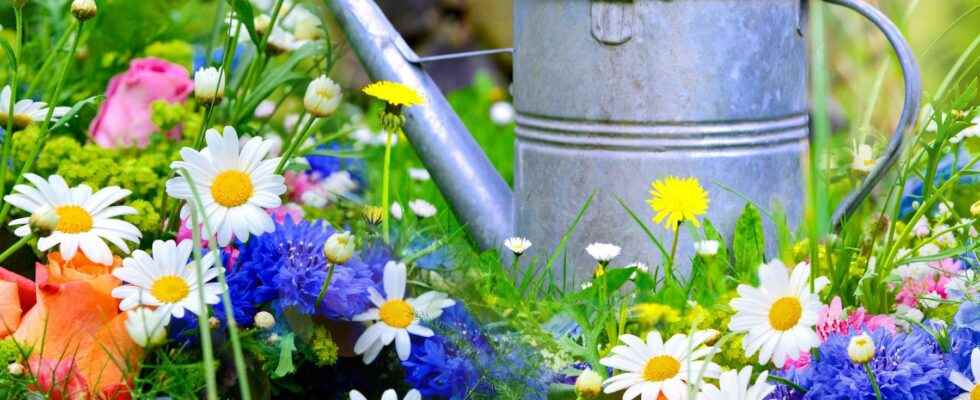Want to go on vacation without worrying about watering? While all plants naturally need water to live, some adapt very well to a dry climate and can go several days or even weeks without watering. And not all of them are cacti! Here is a selection of magnificent flowers that will brighten up your garden all summer long, even in the absence of rain.
You will also be interested
[EN VIDÉO] Interview: how do cacti resist drought so well? Succulents, especially cacti, can survive in extreme climates. Deprived of rain for sometimes several years, these plants have developed interesting strategies to retain water. Futura-Sciences interviewed Jean-Marie Solichon, director of the Exotic Garden of Monaco, to tell us about it.
Some flowers, like iris where the geraniums, need to be watered regularly so as not to wither. Others, on the other hand, adapt perfectly to periods of drought extended. These 10 flowers, in addition to being decorative, will save you the chore watering.
Yarrow
Yarrow is a plant perennial which blooms all summer between June and September. There are hundreds ofspecies, which all adapt to a southern exposure and dry soil. Its tall stems adorned with white or pink flowers produce a beautiful effect in a bed, alone or mixed with other perennials. Outside of flowering periods, yarrow also serves as an effective ground cover. And once cut, you can use it to compose magnificent dry bouquets!
California poppy
The California poppy (Eschscholtzia) produces abundant flowering between May and August. This cousin of the poppy features beautiful single or split bright orange flowers that will look great in your garden. He appreciates the sunadapts to poor soils and limestone as well as strong heat. Plant it mixed with other flowers in a bed or on the edge of rockery. Warning: the California poppy reseeds itself and tends to be invasive!
Delosperm
Native to South Africa and Madagascar, delosperm or perennial purslane is a creeping plant that likes heat and dry soil. There are different colors, ranging from white to pink through bright orange or yellow. Its small flowers quickly cover a large surface, and produce a beautiful effect on the low walls or at the edge of rockery. Resistant to both heat and cold, delosperm requires no maintenance but does not tolerate excess humidity well.
The hollyhock
Despite its name, the hollyhock (Althaea rosea) has nothing to do with a rosebush: it belongs to the Malvaceae family (mallows, hibiscus…). It sports magnificent floral stems 1.5 to 2.5 meters high, passing through all shades of pink. It flowers from June to September, and appreciates well-drained soils. If the hollyhock tolerates the droughts temporary summer weather, it is on the other hand sensitive to wind : we can for example plant it near a low wall to shelter it.
Lindheimer’s gaura
Native to North America, Lindheimer’s gaura (Gaura lindheimeri) has deep roots, which allows it to withstand very dry land, even in full sun. It blooms continuously from June to October, with magnificent white starry flowers edged in pink, surmounting a long stem that can reach 1.5 meters in height. Lindheimer’s gaura adapts to poor soils, even rocky ones, and combines wonderfully with other flowers such as asters, verbena where the Echinacea.
Jerusalem sage
This large perennial plant with yellow flowers erected in tiers is native to the mountains of Turkey. Jerusalem sage (Phlomis fruiticosa) is resistant to cold, heat and Drought. It flowers throughout the summer and produces beautiful evergreen foliage the rest of the year. A bedding plant, Jerusalem sage also thrives on fallow land and sandy soil. pollinated by insectsit will attract the butterflies in your garden.
Cape Daisy
This false daisy with large flowers of various colors is also called rain marigold (Osteospermium). It spreads out in large clumps of up to 1.50 meters in diameter and produces a magnificent “bouquet effect”, ideal for the planters or clumps. The Cape daisy fears the cold (it hardly resists frosts) and needs sun to flourish but in return supports the drought. Its ephemeral flowers last only one day but are very quickly replaced.
ornamental garlic
ornamental garlic blooms between April and October depending on the species, forming a inflorescence into a ball that can reach 10 centimeters in diameter. These colored spheres perched on a stem of 15 centimeters to 1.20 meters tolerate drought very well outside the flowering period. If your region experiences very dry summers, prefer spring varieties. L’garlic ornamental appreciates the sun but not the wind: keep it sheltered from the currents ofair.
Garden valerian
The valerian gardens, or red valerian (Centranthus ruber) is an easy-to-grow short-lived perennial. This stunning pink flower blooms from June to October and grows absolutely anywhere, including dry rocky or sandy soil. It appreciates the heat and the sun, and is used in clumps, rockeries or arid embankments. Valerian reseeds itself and even tends to become invasive. Very nectariferousit will also attract butterflies to your garden.
The gazania
Native to South Africa, the gazania produces large, colorful daisy-like flowers. It blooms continuously from May until the first frosts. Native to South Africa, the gazania flourishes on a balcony very sunny or on a south-facing slope. It requires very little watering and tolerates high temperatures. In regions with climate sweet, it is a perennial, but under our latitudesit is grown more like a annual.
Interested in what you just read?
